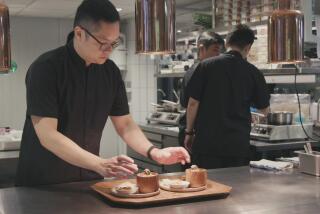Malaysia: This Is What Maugham Had in Mind : In Kuala Lumpur, many things are not as they seem. But this feast for the eyes is enough to make one want to discover more.
- Share via
The English novelist Somerset Maugham was keen on travel, especially to tropical climes. However, if he sat on as many South Seas verandas as they claim, sipping cool Tom Collins’ beneath whirring ceiling fans, it’s a wonder he ever put pen to paper.
These ubiquitous sightings may be why the message at the old-line Selangor Club in the heart of Kuala Lumpur is: “Somerset Maugham REALLY was here.” They have scrapbooks as proof.
The Selangor Club, a blend of mock-Tudor architecture and breezy Malaysian, sprawls above the green space called the Padang. This is where British colonials used to linger in rattan armchairs and escape the heat with a favorite drink: the whiskey-and-soda mix called “stengahs.”
On the Saturday of my visit, a cricket match was under way in the Padang--men in crisp whites playing that most English of sports-cum-tea. Two brides were being photographed near the clubhouse in billowy formal gowns, while their attendants--wrapped in saris of butterfly silk--held pink parasols against the sun.
Across the street, a driveway was marked with palm fronds made of bright foil: magenta, lime green and gold, the traditional sign of a Malay wedding ceremony.
Kuala Lumpur, with 1.3 million residents, translates as Muddy Estuary. The city began at the confluence of the Gombak and Kelang rivers, where the pink-and-white Jame Mosque still nestles like a pile of peppermint candy.
My stay in K.L. was far too short, just a shore excursion from a Southeast Asia cruise. I seemed to spend most of the time staring in amazement from the windows of a slow-moving car, or racing on foot through an old marketplace in order to see the next shrine.
The architecture of the capital is like a flamboyant display of prize-winning examples of Victorian, Chinese, Moorish-Muslim, Indian and 21st-Century styles. The spacing is grand. City officials will not allow a wall of high-rise, I was told.
Each new downtown building--and its landscaping--must be approved for its specific site. Hillside terrain is considered; views are protected. The policy seems to be that a mix of style is desirable. You find a mosque by a bank, a museum by police headquarters, and all--from the outside--are intriguing.
In K.L. they are proud that the alabaster-white railway station, built in 1910 and topped by minarets, is often taken for a mosque. They are amused that the National Mosque, with its reflecting pools and ultra-modern lines, has been mistaken for a luxury hotel. The city’s past is much more evident than in nearby Singapore. And its exotic backdrop of jungle and 6,000-foot mountains adds to the charm.
Many buildings are not what they seem. The National Art Gallery in K.L. used to be the Hotel Majestic; the ornate, onion-domed Sultan Abdul Samad building and clock tower, built in the 1890s, houses the High Courts. The National Petroleum Headquarters--whose riches come from off-shore drilling in the South China Sea--is a white skyscraper with Moorish arches and filigreed screens. Parliament House rises like a luxurious apartment tower above the expanse of Lake Gardens park.
The old neighborhoods, with their warrens of shops, offer night markets, day markets, a Sunday market (it begins Saturday night) and the handcrafts-packed Central Market, a two-level, air-conditioned mall in what used to be the fruit and vegetable market.
The most dazzling structure I saw was the monumental public library, a truncated pyramid of turquoise topped with angular Malaysian designs that bear some kinship to the patterns on Navajo rugs.
Yet all this feast for the eyes made me hungry, so I repaired to a Malay restaurant named Yazmin, in a colonial mansion shaded by banyan trees. The buffet included steaming fish curry, beef curry, laksa (shrimp and noodles), saffron rice, gado-gado (green vegetables in peanut sauce), sliced jicama and cucumbers--with assorted bowls of spicy satays and other peppery sauces.
As I sat beneath a ceiling fan on the open veranda, savoring the fiery food--and an ice-cold Tiger beer--I thought of Somerset Maugham. It was his kind of place.
But no one claims to have seen him there; Yazmin opened eight years after his death.
More to Read
Sign up for The Wild
We’ll help you find the best places to hike, bike and run, as well as the perfect silent spots for meditation and yoga.
You may occasionally receive promotional content from the Los Angeles Times.






